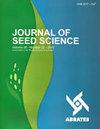水浸改变了巴西热带干燥森林Caatinga树种种子萌发的温度阈值
IF 1.2
4区 农林科学
Q3 AGRONOMY
引用次数: 6
摘要
摘要:研究了不同温度条件下水合脱水循环(HD循环)对四种Caatinga树种(Anadenanthera colubrina var. cebil、Enterolobium contortisiliquum、Pityrocarpa moniliformis和Pterogyne nitens)种子萌发的影响,并确定了萌发的热上限和下限。为此,将种子置于0、1、2和3个HD循环中,并设置在5、10、15、25、35、40和45℃的温度下发芽。计算发芽率和t50,并采用双因素方差分析比较这些参数的差异。此外,通过计算发芽率(GR = 1/t50)、最高温度(Tc)、最适温度(To)和最低温度(Tb)来估计低于或高于种子不发芽的极限。我们观察到,HD循环次数越多,种子的反应就越好,尤其是在极端温度下。所有研究物种的种子温度均为25 ~ 35℃,Tb < 10℃,Tc < 40℃。发芽率回归曲线的斜率表明,高温循环扩大了种子的耐热范围,说明高温预处理对种子的耐热性提高,是有效的。本文章由计算机程序翻译,如有差异,请以英文原文为准。
Hydropriming changes temperature thresholds for seed germination of tree species from the Caatinga, a Brazilian tropical dry forest
Abstract: This study evaluates the effects of hydration and dehydration cycles (HD cycles) on seed germination of four Caatinga tree species (Anadenanthera colubrina var. cebil, Enterolobium contortisiliquum, Pityrocarpa moniliformis and Pterogyne nitens) subjected to different temperatures and determine the thermal upper and lower limits of germination. For this, seeds were subjected to 0, 1, 2 and 3 HD cycles and set to germinate at temperatures of 5, 10, 15, 25, 35, 40 and 45 °C. Germinability and t50 were calculated and the differences of these parameters were compared by two-way ANOVA. In addition, germination rate (GR = 1/t50), as well as ceiling (Tc), optimum (To) and base (Tb) temperatures were calculated to estimate the limits below or above which the seeds fail to germinate. We observed that the more HD cycles, the better the seed responds, especially at extreme temperatures. Seeds of all studied species showed To between 25 and 35 °C, Tb < 10 °C, and Tc > 40 °C. The slope of regression curves for germination rate showed that submitting seeds to HD cycles expands its thermal tolerance range, revealing that this seed pre-treatment can be efficient for species as it increases their tolerance to thermal stress.
求助全文
通过发布文献求助,成功后即可免费获取论文全文。
去求助
来源期刊

Journal of Seed Science
Agricultural and Biological Sciences-Agronomy and Crop Science
CiteScore
2.00
自引率
30.00%
发文量
28
审稿时长
12 weeks
期刊介绍:
From 2017 the Journal of Seed Science (JSS) will circulate online version only.
Original scientific studies and communications, not yet published or submitted to another journal for publication and written in Portuguese or English, will be accepted for publication. For manuscripts submitted in English, the authors should provide an adequated version.
The SCIENTIFIC COMMUNICATION is a category of scientific manuscript which describes a technique, an equipment, new species or observations and surveys of limited results. It has the same scientific rigor as the “Scientific Articles” and the same value as a publication. The classification of a manuscript as a SCIENTIFIC COMMUNICATION is based on its content and scientific merit but it can be a preliminary study, simple and not definitive on a certain subject, with publication justified by its uniqueness and contribution to the area.
The Editorial Board of the JSS may invite leading authors of recognized reputation to compose specific Review Articles covering topics of their specialization that will convey to the scientific community the state-of-the-art knowledge related to the specific theme.
 求助内容:
求助内容: 应助结果提醒方式:
应助结果提醒方式:


